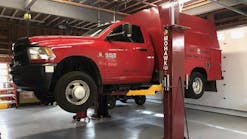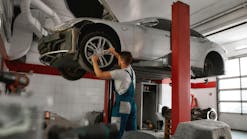Use vehicle inspections as an optimized approach to customer satisfaction
Efficiency and accuracy are crucial aspects of any automotive repair shop's operations, these days more than ever. To enhance customer satisfaction and ensure vehicles receive comprehensive care, an optimized inspection process is essential. By incorporating factory-scheduled maintenance checks and a thorough vehicle service history review, repair shops can streamline their operations, provide better service, and deliver a higher level of customer satisfaction.
Factory-scheduled maintenance guidelines serve as valuable roadmaps for keeping vehicles in optimal condition, along with assuring that they are safe and reliable. By following these guidelines, repair shops can ensure that all necessary maintenance is performed at the recommended intervals. Incorporating factory-scheduled maintenance checks into the inspection process helps identify any missed or upcoming maintenance requirements, allowing technicians to address them promptly. This includes items such as oil service, filter replacements, fluid flushes, a battery load test, and a variety of visual inspections to make sure everything is as it should be and more. By adhering to these manufacturer recommendations, repair shops help prevent potential issues and ensure vehicles receive the care they need.
Review the service history to be proactive on maintenance suggestions
A vehicle's service history provides invaluable insights into its past maintenance and repair work. Reviewing the service history allows technicians to identify recurring problems, previously addressed issues, and any outstanding concerns. It also keeps on our radar service and repair items that a customer might have declined on a previous visit so they are not overlooked or forgotten about. This comprehensive understanding helps technicians diagnose current problems more accurately, eliminate unnecessary repairs, identify potential warranty coverage, and helps assure the customer that we are on top of keeping their car serviced and well maintained. By reviewing the service history, repair shops can also recommend proactive maintenance measures based on the vehicle's age, mileage, and historical patterns. This proactive approach not only improves the vehicle's overall condition but also enhances customer trust and satisfaction.
Use digital inspections for speed and efficiency
To further optimize the inspection process, repair shops can leverage digital tools and software solutions. Digital platforms enable technicians to access and review a vehicle's service history quickly and efficiently. Additionally, these tools can provide automated reminders for factory scheduled maintenance checks and generate comprehensive reports for customers. By integrating digital tools, repair shops can streamline their workflow, reduce paperwork, and enhance overall efficiency, resulting in faster turnaround times and improved customer experience.
Effective communication is vital throughout the inspection process. Repair shops should encourage open dialogue with customers, ensuring they are aware of the inspection process, its purpose, and any findings. Service advisors should communicate maintenance recommendations, repair needs, and associated costs clearly and transparently. This approach builds trust with customers and helps them make informed decisions regarding their vehicle's maintenance and repairs. Providing detailed explanations and answering any questions customers may have can go a long way towards fostering a positive and long-lasting relationship.
Maintaining accurate and organized documentation is essential for an optimized inspection process. Repair shops should create and maintain comprehensive records of each vehicle's inspection results, maintenance services performed, repairs completed, and any recommendations made for every vehicle coming into the shop. These records can serve as a reference point for future inspections, aid in warranty claims, and provide valuable information for customers. Well-documented records not only facilitate efficient operations but also demonstrate professionalism and accountability.
Enhance efficiency, accuracy, and customer satisfaction
By integrating factory-scheduled maintenance checks and a thorough vehicle service history review into their inspection process, automotive repair shops can enhance their efficiency, accuracy, and customer satisfaction. Adhering to manufacturer recommendations and leveraging digital tools enables shops to identify and address maintenance requirements promptly, while reviewing the service history provides valuable insights for diagnosing and recommending repairs. Coupled with effective communication, transparent explanations, and detailed record-keeping, this optimized approach sets the stage for a seamless inspection process that delivers the highest level of service to customers.
Most of the shop owners I have known over the years would claim to take great care of their customers. But somehow when consumers are surveyed, almost assuredly their number one complaint is what they are experiencing when they take their car in for service. This, when combined with the billions and billions of dollars in unperformed and underperformed maintenance reported year after year, would have me believe that we, as an industry, could do better, both in our approach to customer service and in our approach to vehicle inspections, vehicle maintenance and customer experience in the middle of all this.
Our customers can go anywhere. But as shop owners and service managers, we need to find ways to assure our existing customers that they have great reasons to stick with us and keep coming back. At the same time, we need to be sure we are visible and attractive to would-be customers who are out there looking for a home.
If you go to a restaurant and get lousy service, would you go back? No matter how good the food is or how impressive the wine list, if you get lousy service, the chances are very good that you will go somewhere else. What happens to your customers when they get lousy service?
My wife and I have a great restaurant we go to for our anniversary or any time we have a special occasion we want to celebrate. It is way out of the way and very expensive. Of course, the place is beautiful, the food is great, and the wine list is as long as my arm. But what keeps us coming back again and again, year after year, is their great service. From the moment we walk in the door, it is almost as if we were their only customer; they do everything to make us feel special and appreciated. They always remember our names and always make whatever occasion we are celebrating that much more special. We always spend way too much money, but we don’t even think about that, they always exceed our expectations, and we always feel the value.
I was just wondering, where do your customers go when they are willing to spend way too much money?
Maybe it’s time to think about that.



